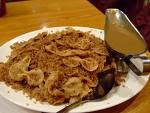These days, almost everyone interested in cooking knows about sofrito. It wasn’t always like that. When I was growing up, the condiment was hardly known outside of Hispanic and Puerto Rican enclaves in East Harlem and the South Bronx. My Anglo friends had never heard of it until I mentioned it to them. My Mexican friends stated they had their own version of sofrito, But that’s as far as it went. Then with the culinary explosion that enveloped America from the 1970s on, sofrito was popularized. This aromatic mix of herbs and spices, used as a base for countless Caribbean dishes, became the darling of innovative cooks everywhere.
As I demonstrated in my video on the topic (7/10/14), sofrito is an easy mix to conjure up. In my culture we use it for flavoring stews, casseroles, soups, meat, poultry, seafood, you name it. However, I got to thinking: what about combining it with one of my favorites—pasta? Has it even been tried? In recent years the talk has been about “fusion cuisine.” Well, what would be more daring than sofrito with linguini, or rigatoni, or penne, macaroni— whatever brand of pasta you like, be it strand or tubular?
So recently I set myself an experiment, and decided to combine sofrito with a pasta type. In this case, perciatelli. I love perciatelli. It looks like spaghetti but it’s slightly chunkier, more like a cable than a strand. As my father woulds say, “It’s a manly-man pasta!” No angle hair in this family. Not that there’s anything wrong with angel hair or other fine pasta. Just that perciatelli (like fettuccine) sticks to the ribs. Anyway, if you don’t want percialtelli, use whatever pasta suits your taste.
Naturally, in all of this, the main ingredient is sofrito. And a basic recipe for sofrito would include 1/2 cup parsley or 12 whole leaves recao (a small green stemmed herb found in Hispanic, Oriental, or Indian markets); 1/2 cup of cilantro; l medium green bell pepper, chopped; 2 cloves garlic. crushed; 1 medium onion, coarsely chopped; and 1/4 pound sweet chili peppers (also known as aji dulce–but they’re sweet, not hot and spicy. They’re sold loose by the handful or in 1/4 or 1/2 pound packets. A 1/4 pound packet contains about 12 peppers). Combine all the ingredients in a blender or food processor, with 1 tablespoon olive oil, and puree until it has a smooth, sauce-like consistency. This will yield about 1 1/3 cups of sofrito. You can store the sofrito in a closed jar or container in the fridge for 3-4 days, on in the freezer compartment indefinitely.
SOFRITO WITH PASTA
2 tablespoons olive oil
1/3 cup sofrito
3 tablespoons tomato paste
1 pound ground beef, turkey, or chicken
1 medium zucchini, sliced into 1/4-inch sticks about 1-inch long
1/2 cup water or chicken broth
Salt and ground black pepper to taste
1 pound perciatelli (or any other pasta—your choice), cooked according to package directions
2 tablespoons fresh, chopped parsley
1. Heat olive oil over medium heat in a large skillet or pot. Add sofrito and tomato paste, and cook, stirring constantly with a wooden spoon, about 2-3 minutes.
2. Add ground beef or poultry and cook until meat loses its red color (5-7 minutes). Again, stirring frequently to break up any lumps in the meat.
3. Add the zucchini, stir to mix. Season with salt and pepper. Add the water or chicken broth, cover, and simmer on low heat for 20 minutes. Check periodically: if the meat becomes too dry, you can add more water or chicken broth.
4. Add the cooked pasta. Stir to combine, sprinkle with the parsley, and serve.
Yield: 4-6 servings.










![Reblog this post [with Zemanta]](http://img.zemanta.com/reblog_e.png?x-id=8757a9c7-a935-47a1-864e-f5787a7a7870)

